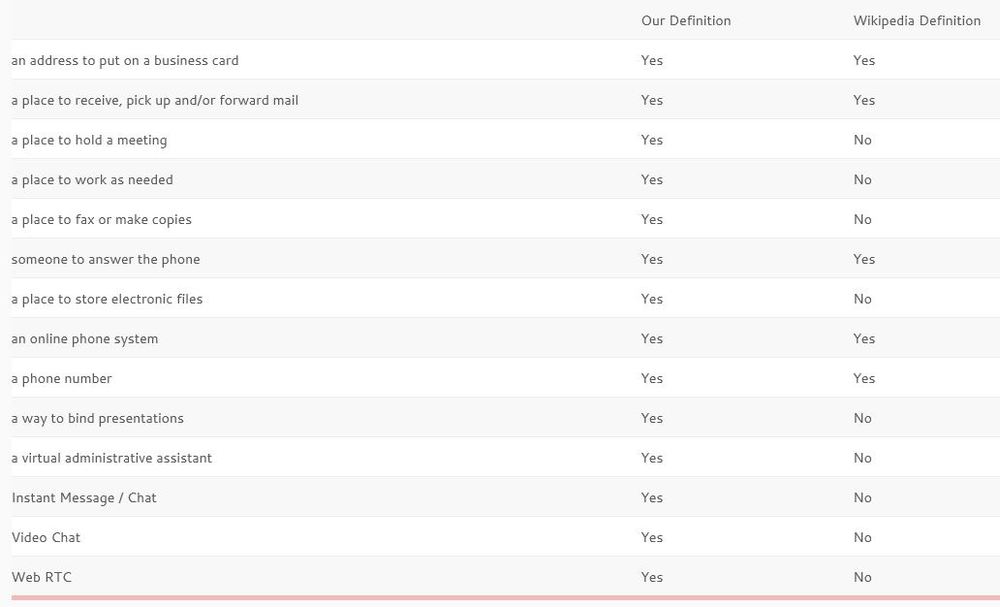As part of our journey to clarify the history of virtual offices, we at Alliance Virtual Offices have had the pleasure of speaking with some early pioneers of the virtual office movement. Our friends at OfficingToday have also undertaken research focusing on the roots of the sector and, while the process is still ongoing, we want to update you with some important revelations that have come to light. For details of conversations and interviews to date, please see these articles:
- Interview with Marcus Moufarrige, COO Servcorp (OfficingToday) – Servcorp is one of the world’s largest providers of virtual offices and an early adopter of the service. In the late 1980s, the company referred to it as ‘Networking’ then ‘Company Headquarters’, and by the mid nineties started branding it ‘Servcorp Virtual Offices’.
- Interview with Richard Nissen, founder of ‘The Virtual Office’ (Alliance Virtual Offices blog) – Business center operator Richard Nissen was an early pioneer of the virtual office concept, and trademarked the term ‘the virtual office’ in the UK in 1992.
- Timeline of the virtual office – We decided to compile a timeline of milestones in the world of virtual offices, and we found a few surprises. Especially the one from 1973!
——————
The flexible workplace industry, and its component offerings — like the virtual office — are often perceived by those in and around the industry to be misunderstood, overlooked or worse yet, completely unknown to those who might benefit from the industry’s services. In the past ten years, a new movement — coworking — within the flexible workspace industry has arisen and surpassed serviced offices and virtual offices in terms of popularity and buzz, and perhaps in other ways too.
I would posit the reason virtual offices do not see the growth and buzz that they could is due to a lack of good, clear communication of what it is, and the broad based benefits associated with having a virtual office. I decided to take a look at top google results for definitions of “virtual office”. The results were enlightening. While I don’t think a definition on Wikipedia or some other website will make or break an industry, I do believe if all the definitions are poor, it reveals that the originating sources of communication (those in the industry) are perhaps poor as well.
The emergence of the collaborative internet has revolutionized and democratized the function of defining terms. Definitions and classifications no longer rest solely in the hands of unseen publishers. Any individual with any knowledge of a subject or term may become more-or-less directly involved in creating and revising its various definitions and functions.
Of course, sometimes collectively defining terms can be a little trickier than it seems. This particularly can be said of technology-related terms, which tend to take on new meanings and connotations as technology advances.
Take our words “virtual” and “office” for example. Both of those words have existed nearly 100% independent of each other throughout their entire existences. “Virtual” was an adjective living a pretty static existence until the 20th century, when the advent of computers and software suddenly shaded the word with unpredictable implications and applications. “Office,” having more literal than metaphorical definitions, continued to live a static existence until computing technology conspired to combine the two into a single term whose meaning is more than the sum of its parts. Like many compound terms, its meaning cannot be understood as simply a combining of the two traditional definitions.
Things are further complicated by the quaint trend of referring to anything Internet-related as “virtual,” a somewhat short-lived trend whose ghost nevertheless haunts the term “virtual office,” encouraging the simplistic notion that the term merely means “a (metaphorical) office on the Internet,” or something equally nebulous and hazy.
These simplistic notions have crept into the ongoing discussion and definition of the term, a problem the online community needs to use its collaborative powers to remedy.
For instance, Investopedia (one of the top non-commercial results in a google search ) defines “virtual office” in such a way that it almost says nothing at all beyond an outdated, surface reading of the two terms separately:
A business location that exists only in cyberspace. A virtual office setup allows business owners and employees to work from any location by using technology such as laptop computers, cell phones and internet access. A virtual office can provide significant savings and flexibility compared to renting a traditional office space. Meetings can be conducted via teleconferencing and video conferencing, and documents can be transmitted electronically. Some companies even provide virtual office services to give virtual offices the prestige associated with physical offices, such as an important-sounding address, a professional phone-answering service and even occasional rental of office space and conference rooms.
This definition, as meaning-free as it mostly is, is more harmful than neutral, as it just encourages an inaccurate understanding of a new thing that was born of two disparate concepts.
Also, it is full of logical fallacies.
First, there are any number of businesses, including Alliance Virtual, that can provide an address to include as part of your virtual office — not merely a “cyberspace” location, but a physical location that you can put on your business card, and where you can pick up mail or to meet with a client.
Second, I am not really sure how to argue for or against the idea of a “location” being “cyberspace” and have decided against trying. I think the reader will understand why.
Not very helpful, to say the least.
Unfortunately, despite its growing reliability and accuracy, and despite its continuing reign as the most prevalent place to define terms, Wikipedia doesn’t really do any better with its two proffered definitions. In fact, one of the alleged definitions (the one for “Virtual Office”) is not so much a definition as a veiled advertisement by a company who created a cloud-based server product. I would call for this entry in Wikipedia to be removed altogether.
The entry for “virtual office” (link to the latest snapshot from January 28 is here and I will link to the snapshot rather than the actual entry due to the fact it will change, hopefully for the better after people read this post) is a little better, but still very much focused on the narrow view of a single industry and therefore limited in scope:
A virtual office provides communication and address services without providing dedicated office space.
This is a noble start to a definition, but like the other current web definitions of virtual office, it suffers from a significantly narrowed scope. Definitions like this are usually written by someone with special interests in a particular industry, or by someone unaware of the broader applications of the component parts of the virtual office, and how those aspects can enable people to work more efficiently. Also, it attempts to define the term by saying what it is not, which is always less than ideal.
Another nitpick issue with the Wikipedia definition is actually a logical fallacy: it says “communication and address services”. This is a case of sloppy writing mirroring sloppy thinking. By using “and,” it is saying that one has to have both to have a virtual office. In other words, if you just have address services, like a UPS Store or other brand mail depot, you are not a virtual office; or if you just offer VoIP, you are not a virtual office. I’d say the head of all mail depots and VoIP systems would take some exception to such categorization.
We could continue to parse the Wikipedia entry and find multiple flaws in every sentence, unfortunately. Most of the problems come from sloppy thinking/writing, but there is also evidence of obvious company shilling. This is sometimes a problem for Wikipedia, given its “anyone can contribute” collaborative nature; “anyone” unfortunately includes shills and advertising specialists.
For instance, further down the “virtual office” entry page, you will find information that has likely been planted by a company in the industry, and which provides no real value to someone wanting to know what a virtual office is:
Some virtual office companies or telephone answering companies offer a franchise system, enabling entrepreneurs to enter the marketplace for a fraction of the usual set up costs and with the added bonus of leads being fed to them.
This is likely a marketing ploy to allow someone who is doing research (perhaps someone who is thinking of starting some sort of company) to know there are franchise opportunities available.
I have marked up the Wikipedia page as it currently exists and we count about 200 problems. I stopped counting when my brain began to have trouble processing how many inaccuracies can exist in a single sentence.
But let us not simply curse this darkness; let’s light a candle. Since Wikis are collaborative, let’s collaborate and see if we can improve upon the Wikipedia definition by developing a more genuine, transparent, balanced view of what a virtual office is:
A virtual office is any or all of a combination of people, place, technology and processes (the “Virtual Office Infrastructure”) which enable individuals and entities to work more efficiently, whether remote (at home, in Bora Bora) or in some non-centralized office (with its corresponding technology and people that may inhabit it). Usually, the infrastructure is paid on an as-needed and/or recurring basis as opposed to capital expenses associated with typical office infrastructures (land, buildings, equipment).
We feel this definition moves us at least a little closer to a useful, inclusive, and accurate definition, one that includes far more aspects that most would consider part of a virtual office.
Such a revised definition is necessary, because the virtual office infrastructure is shared across individuals and entities, allowing resources to be allocated more efficiently. There are no dedicated servers, or dedicated offices or dedicated receptionists, for example. All is shared in order to make more efficient use of the infrastructure. In theory, there is unlimited capacity and inventory, yet there is little or no excess inventory or capacity. In practicality, of course, there are limits to capacity and inventory, and there are often predictable capital expenses on the part of the provider (but not the consumer) and overhead associated with increasing usage.
For a more concrete example, think of Digital Ocean’s cloud server infrastructure (or Amazon Web Services or Rackspace). In the recent past, one of the only ways to have back up was to partition your existing hard drive or to buy a new server. But now, for $15 per month, a company can back up its entire website and customer data in a safe and secure environment on a recurring basis with little to no manual intervention. Of course a new server that could hold the data might cost a few thousand dollars and would require someone on a regular basis to run the jobs that backed up the data.
This is just one small, optional component, but it neatly illustrates why web definitions such as Wikipedia’s need some work in order to truly reflect the phenomenon that is the virtual office. To further put things in perspective, let’s lay out a list of services our definition of “virtual office” allows for, and compare and contrast these items with the current Wikipedia definition:

As this table clearly confirms, the Wikipedia definition needs a lot of work, much of which can be facilitated by a quick look into the history and evolution of the virtual office and its place in the larger global picture.
History of the Virtual Office
Just as the Wikipedia entry on “virtual office” leaves much to be desired in terms of definition, its “History” section is woefully lacking. This is an important component that needs work, since understanding the history of a term is crucial to understanding its definition/s.
Part of the difficulty in delineating the history of the virtual office is knowing where to begin. Since a virtual office is a broad concept, enabled by our advancing technologies, where do you start? Do you start with the advent of the transistor? Do you start with the artisan guilds where people shared workspace in the Middle Ages?
To simplify, let’s focus on a number of trends in relatively recent history that converged to get us to where we are today. A good place to start is with globalization, specifically the first “modern” globalization, as described by The Economist. About 50 years before World War I, the world saw an amazing proliferation of globalization, enabled by reduced tariffs and new technology — in the form of ships and trains – that allowed the transport of goods efficiently across borders and around the globe. According to The Economist, this stopped during WWI and did not really return until the 1980s as countries liberalized their trade policies, and as communications technology — this time in the form of computing rather than shipping — advanced further into businesses and homes.
Not surprisingly, the early 80s was the time when the term virtual office first began appearing in our lexicon. Two writers, first John Markoff in 1982 and (independently without the knowledge of John Markoff’s writing) Chris Kern in 1983 began to describe the phenomenon very well. Chris’s definition of “Virtual Office” in American Airline’s inflight magazine was:
The virtual office is a set of capabilities at remote site that are indistinguishable from those available at a real, physical office.
Now, back to the globalization trends of the 1980s.
Thanks to these advancements in communications, there are very few isolationist countries any more. Much of the globe is participating. This also makes it easier for workers to be mobile (although The Economist article points out that workers are still staying in their home countries more than expected due to certain barriers).
Not only does communication continue to get easier, but the costs of communicating are approaching zero, which enables individuals and entities to reorganize the way they work globally. Also, computing/communication devices are constantly getting smaller and more powerful. These factors, considered together, have helped make the virtual office not a novelty or luxury, but practically a necessity (which makes Mr. Kern’s article seem quite funny, I think). The almost age-old notion of needing to plant oneself in one spot in order to conduct efficient, profitable business is now quaint.
With all of this change and advancement as a background, consider key moments that have enabled “Virtual Office Infrastructure” to exist:
- Paul Fegen started the first serviced offices;
- VoIP technology was created by our friend Alon Cohen (of phone.com) in 1989;
- Al Gore invented the internet Arpanet established the technology which was the underpinning of the internet in 1969. And Tim Berners-Lee.
- In the 1960s, Private Automated Business Exchanges (PABX) began to be used to centralize call functions. These later became known as “call centers”.
- Carrier pigeons delivered mail 300 years ago, and started the first mail depots (this is where my knowledge of history grows fuzzy and my desire to do research waned, but I’m going with it)
Notice how understanding such historical milestones enables us to arrive at the definition of “virtual office” that we proffered earlier:
- Place: Paul Fegen’s shared offices.
- Technology & communication: Tim Berners-Lee’s protocol, Arpanets packets and Alon Cohen’s audio transceiver.
- People: Again in the form of Paul Fegen’s shared resources, including call center receptionists, maintenance and other staff.
Clearly these concepts have evolved drastically and are applied in many different ways, backed by heaps of interesting and innovative processes — all of which goes together to make what we know as the modern virtual office.
Some interesting movement on Wikipedia’s “virtual office” entry over the years
This section is more of a sidebar to the foregoing information. Its intent is to help us learn from our past mistakes, and displays at worst our petulance or at best our unwillingness to recognize that many people have played many roles over decades to get us where we are today. There is no one person or moment that caused the transition to the amazingness that is the virtual office.
Currently, one of the statements in the current version of the Wikipedia entry says:
The first commercial application of a virtual office occurred in 1994, when Ralph Gregory founded “The Virtual Office, Inc” & later “Intelligent Office”, in Boulder, Colorado.[Citation is to an article in the Boulder Daily Camera, but cannot be found online] Since then & over the years, the industry has grown further with industry leaders like Davinci Virtual, Regus & Synergy [Synergy??? What?? They shuttered their doors years ago.], among others, who now offer worldwide access to offices in almost every country in the world.
If you look at previous versions of this wikipedia entry, you’ll find a number of changes to it, with reference to Servcorp’s Alf Moufarrige pioneering the virtual office concept, to Chris Kern coining the term (but not commercializing it). Check these out here from Wikipedia in 2009, here from Wikipedia in 2011, and back to here in 2012. I also remember seeing Richard Nissen of The Virtual Office at being given a go at being the pioneer, but I had no luck finding it in the Wikipedia archives (more on this in a moment, as it looms large).
The reality is that the product that constitutes a virtual office in the serviced office industry was around before 1994. Likely, Mr. Gregory is saying that he was the first to take the term “virtual office” and apply it to a set of services others were selling.
I can’t grant him that claim, however.
It was very simple to do some research on Mr. Nissen to see that he has stated that he had the forethought to trademark “The Virtual Office” back in 1992… and lo and behold, a 30 second internet search lead me to this page. So, we’re sorry Mr. Gregory. At this point I don’t think we can grant you the first commercial application of the product known as a virtual office any more. I believe it must go to Mr. Nissen. Please let me know if I am mistaken. I do this in the name of science. Science doesn’t rely on citations from interviews or other unverifiable information.
The citation that is used in the Wikipedia for Mr. Gregory’s virtual office claim is to an article that appeared in Boulder’s Daily Camera newspaper. This article probably existed, but it doesn’t seem to be available online anywhere. Perhaps on microfiche somewhere? Oh, it doesn’t matter… it was 1994 and we have proof of 1992 trademark describing exactly the product, and we know Mr. Nissen’s company was selling the product.
So, it is disingenuous as it is very misleading.
There is also ample proof of others in the serviced office industry selling what were commonly referred to as “business identity” plans, often coupled with the nicely descriptive phrase “everything but the office.” I consulted with Carrie Gates at Barrister Executive Suites whose predecessor company was Fegen’s Law Suites. In the image below, you can see a contract written for a client from 1992 (which as a side note, is still a client 24 years later as of this writing) for a business identity plan. Also, check out this video (scroll down).
I don’t discount Mr. Gregory’s role in helping to popularize the virtual office. But there are those who have similarly, and likely some to a greater degree, contributed to the service offering. I would proffer that there are laureates, who are truly the founders of the virtual office. I’m talking about Tim Berners-Lee, Alon Cohen, Paul Fegen, the inventor of the PABX or automated call center (whoever that may be), etc. Then there are the founders of the concept of communications and address services we have in our industry, originally called “business identity” then “virtual offices.” I would posit a short list, that could go on indefinitely (in no particular order): Richard Nissen, Ralph Gregory, Alf Moufarrige, Mark Dixon, Vince Otte, Frank Cottle (perhaps I’m biased as he is our CEO and Founder, but I don’t think many would argue the point that he pioneered the concept of wholesaling of virtual offices now leveraged in various flavors by Davinci Virtual, Cloud Virtual Offices, Allied Virtual, Opus Virtual Offices, and of course, Alliance Virtual Offices)… and I would say I’m not knowledgeable enough to know who else to put in this list.
There are some other quite significant late comers to the game, such as Bill Grodnik at Davinci Virtual, who has done a tremendous job growing a great company that was founded in 2006. This company was built on the initial foundation of Alliance member locations and Frank Cottle’s concept of wholesaling. You can hear Mr. Grodnik talking about ABCN’s contribution to his early development on our (ABCN) Youtube channel.
What next?
Like all worthwhile things, creating and maintaining a relevant, profitable business model requires attention to detail and precision. This is one of the reasons why so many people seek out the services of the virtual office in the first place.
So it only makes sense to be detailed and precise about how we define what it is we do – and more than at any time in history, we collectively hold the power to influence that definition in a very real way, and to assure its accuracy and legitimacy. The days when dubious, vague definitions could permeate the culture and thrive unchecked are gone. Collaboration changed all that, much as it spawned the virtual office itself.
In that spirit, we hope this sparks a meaningful discussion that helps us create a great new Wikipedia page for starters, one that mobilizes us to tell our story more clearly, articulately and coherently.
Or, as Carrie Gates said when I was discussing this with her, “If we as an industry cannot clearly define what/who we are – how can we expect the general public to ‘get it’ and understand what we are?”
Exactly. We don’t want people leaving our “elevator speech” still wondering what we offer and how relevant and important it is. And we certainly don’t want them stumbling over wildly inaccurate and/or incomplete definitions on the Internet.
Why not join us? We’ve already gotten the Wikipedia page partially re-written (but not public yet), and we’re trying our darnedest to be neutral. Those who want to join us, please let us know. Those who want to play games, please go elsewhere.
Blog provided by Alliance Virtual Offices







